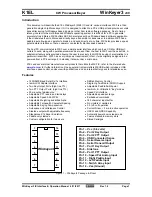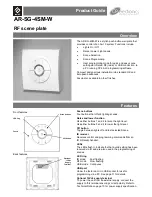
35
TMS320F28069, TMS320F28068, TMS320F28067, TMS320F28066
TMS320F28065, TMS320F28064, TMS320F28063, TMS320F28062
www.ti.com
SPRS698F – NOVEMBER 2010 – REVISED MARCH 2016
Submit Documentation Feedback
Product Folder Links:
TMS320F28069 TMS320F28068 TMS320F28067 TMS320F28066 TMS320F28065
TMS320F28064 TMS320F28063 TMS320F28062
Specifications
Copyright © 2010–2016, Texas Instruments Incorporated
(1)
Write/erase operations outside of the temperature ranges indicated are not specified and may affect the endurance numbers.
5.14 Flash Timing
Table 5-11. Flash/OTP Endurance for T Temperature Material
(1)
ERASE/PROGRAM
TEMPERATURE
MIN
TYP
MAX
UNIT
N
f
Flash endurance for the array (write/erase cycles)
0°C to 105°C (ambient)
20000
50000
cycles
N
OTP
OTP endurance for the array (write cycles)
0°C to 30°C (ambient)
1
write
(1)
Write/erase operations outside of the temperature ranges indicated are not specified and may affect the endurance numbers.
Table 5-12. Flash/OTP Endurance for S Temperature Material
(1)
ERASE/PROGRAM
TEMPERATURE
MIN
TYP
MAX
UNIT
N
f
Flash endurance for the array (write/erase cycles)
0°C to 125°C (ambient)
20000
50000
cycles
N
OTP
OTP endurance for the array (write cycles)
0°C to 30°C (ambient)
1
write
(1)
Write/erase operations outside of the temperature ranges indicated are not specified and may affect the endurance numbers.
(2)
The "Q" temperature option is
not
available on the 2806x
U
devices.
Table 5-13. Flash/OTP Endurance for Q Temperature Material
(1) (2)
ERASE/PROGRAM
TEMPERATURE
MIN
TYP
MAX
UNIT
N
f
Flash endurance for the array (write/erase cycles)
–40°C to 125°C (ambient)
20000
50000
cycles
N
OTP
OTP endurance for the array (write cycles)
–40°C to 30°C (ambient)
1
write
(1)
The on-chip flash memory is in an erased state when the device is shipped from TI. As such, erasing the flash memory is not required
before programming, when programming the device for the first time. However, the erase operation is needed on all subsequent
programming operations.
(2)
Typical parameters as seen at room temperature including function call overhead, with all peripherals off. It is important to maintain a
stable power supply during the entire flash programming process. It is conceivable that device current consumption during flash
programming could be higher than normal operating conditions. The power supply used should ensure V
MIN
on the supply rails at all
times, as specified in the Recommended Operating Conditions of the data sheet. Any brown-out or interruption to power during
erasing/programming could potentially corrupt the password locations and lock the device permanently. Powering a target board (during
flash programming) through the USB port is not recommended, as the port may be unable to respond to the power demands placed
during the programming process.
Table 5-14. Flash Parameters at 90-MHz SYSCLKOUT
PARAMETER
TEST
CONDITIONS
MIN
TYP
MAX
UNIT
Program Time
16-Bit Word
50
μ
s
16K Sector
500
ms
8K Sector
250
ms
4K Sector
125
ms
Erase Time
(1)
16K Sector
2
s
8K Sector
2
4K Sector
2
I
DDP
(2)
V
DD
current consumption during Erase/Program cycle
VREG disabled
80
mA
I
DDIOP
(2)
V
DDIO
current consumption during Erase/Program cycle
60
I
DDIOP
(2)
V
DDIO
current consumption during Erase/Program cycle
VREG enabled
120
mA
















































